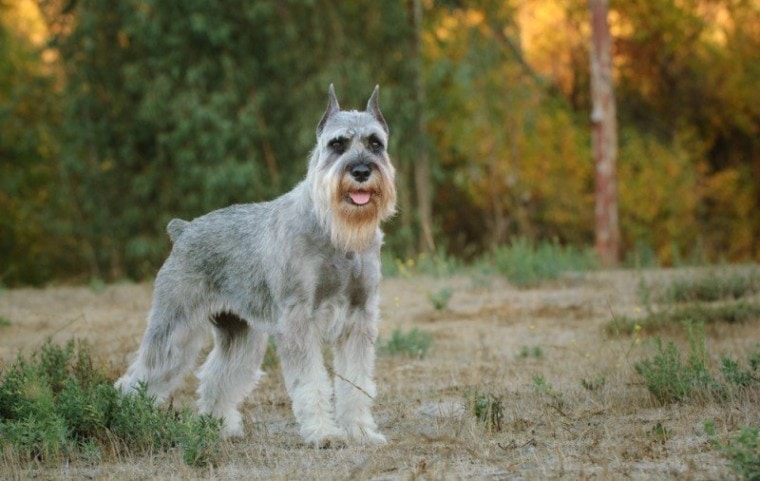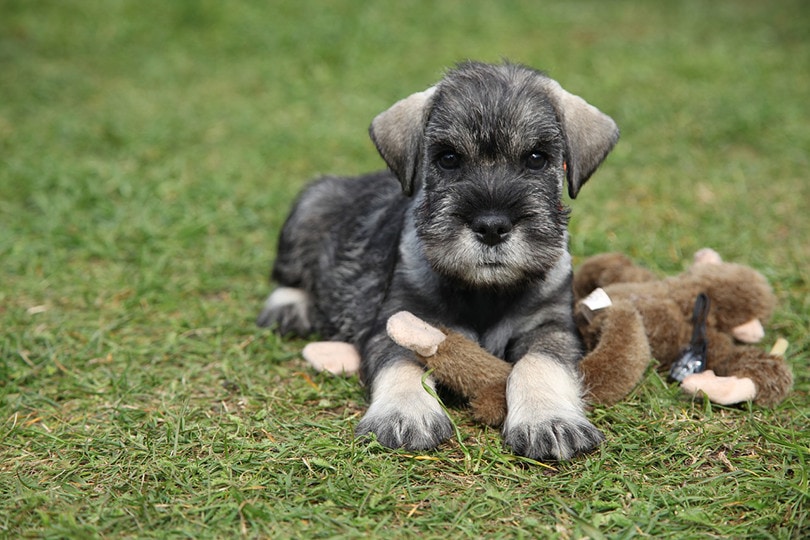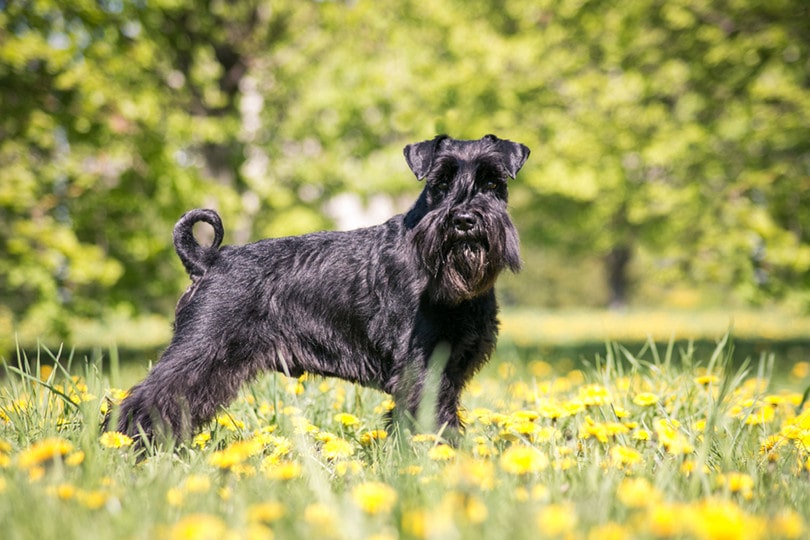
Click Below to Skip Ahead
The Standard Schnauzer is a German breed that was originally used for ratting but also found multipurpose use on farms. They are medium-sized dogs, tend to be protective and watchful of their humans, and they will normally get along with all family members including children, other dogs, and potentially even cats, although they can show aggression towards dogs outside the family. It’s also worth noting that they are prone to barking at anything unexpected, and they do possess a big-dog bark, which could be annoying for close neighbors.
Breed Overview
Height:
17-20 inches
Weight:
30-50 pounds
Lifespan:
13-16 years
Colors:
black, salt and pepper
Suitable for:
Active families looking for a devoted guardian and companion
Temperament:
Devoted, loyal, energetic, playful, clever
As well as being great family protectors, Standard Schnauzers are hard-working, intelligent, and lively dogs. They are attractive, too, and carry themselves with confidence. Their wiry hair does not shed much, and they are said to not exhibit a doggy smell. However, their facial hair does require some maintenance because it tends to become dirty and can be filled with food and other detritus.
Playful and occasionally mischievous, the Standard Schnauzer is clever and loves to please its humans. This combination means that it is considered a moderately easy breed to train, but with the caveat that it needs plenty of socializing to prevent aggressive behavior towards other dogs, and ongoing mental stimulation, to prevent it from becoming bored. It is also beneficial to keep training sessions short and fun.
Standard Schnauzer Characteristics
Standard Schnauzer Puppies

The Standard Schnauzer is purebred, which means that it can attract a high price, especially if it is considered for exhibitions or show standards. Always ensure that the puppy comes with the appropriate documents from the American Kennel Club, Canadian Kennel Club, or your country’s specific kennel club.
If you are looking for a pet-standard Schnauzer, the price is much more modest. Registration papers are not necessary for these puppies.
When buying from a breeder, ask plenty of questions about the Schnauzer breed, any puppies that they currently have or are expecting within the next few months, and the conditions that the parents and puppies are kept in. All these factors will determine the social and emotional skills of the dog, and they can also impact the general health of the puppy when you take it home.
Schnauzers are popular enough that you should have a few breeder options available to you. Compare prices, conditions, and communication from prospective breeders. Do check the general health of the puppies, as well as their parents. Although the Standard Schnauzer is purebred, it does tend to bark quite a lot and a poorly exercised or badly trained Schnauzer can develop some bad and antisocial habits. As such, they can sometimes find themselves in the care of local shelters.

Temperament & Intelligence of the Standard Schnauzer
Whether kept as a family pet or a working dog, the Schnauzer is an intelligent breed and needs to be kept mentally stimulated and entertained. This is especially important if kept in an apartment because, while it is a medium breed, it does require plenty of exercise and benefits from time spent outdoors. Furthermore, the breed tends to bark at anything unexpected or out of place, which can make it a nuisance to neighbors.
Are These Dogs Good for Families? 👪
The Schnauzer is a good family dog. It will form bonds with all family members, rather than sticking closely to the person that feeds it, walks it, or pays it the most attention. It will appreciate active children and will likely jog alongside your kids as they go about their business. It is also quite forgiving and understanding, which is important when mixing dogs and kids.
Does This Breed Get Along with Other Pets?
The Schnauzer is also said to be good with other pets in the same household. It will befriend family dogs and can benefit from having a willing play partner. Although introductions should be gradual or dome at a young age, it will also get along with family cats. However, the Schnauzer is a ratter, so you should never leave it alone with smaller animals because it will instinctively want to give chase.
Things to Know When Owning a Standard Schnauzer:
The Schnauzer is good for families, although may not be the best choice to live in an apartment. It will get along with family pets and still finds utility as a working dog, but it barks a lot, requires plenty of exercise, and its facial hair does take some care, so it is not the ideal choice for all potential owners.
Food & Diet Requirements 🦴
As a medium breed with reasonably high energy levels, the Standard Schnauzer has a moderate daily diet. If you feed dry food, ensure that it is of good quality with enough protein from beneficial sources. Expect to feed between one and two cups per day depending on size, age, activity levels, and the general health of the dog.
If you feed wet food, follow the manufacturer guidelines, and weigh your dog to ensure that you feed an accurate and consistent amount.
When using treats for training and for general good behavior, take these into account in your daily feeding calculations, to ensure that you aren’t giving too many calories to your pup.
Exercise 🐕
The breed is from the working class and is a terrier, so you should expect moderate to high energy levels, as well as a good degree of playfulness and mischievousness. Exercise can take the form of walks, although the Schnauzer will also benefit from more vigorous exercise that also challenges it mentally. One hour of walks per day is a good level to start from, and supplement this with regular playtime. Agility classes and canine sports like flyball are also a good choice for this rat hunter.
Training 🎾
The Standard Schnauzer is something of a mixed bag when it comes to training. On the one hand, it is very intelligent and does like to please its master. However, it is also a playful terrier. It is liable to give chase when out on walks and especially if let off the leash, and it has a single-minded approach to chasing which means that it can be very difficult to get its attention away from its quarry.
Keep training fun, be consistent with your commands and rewards, and give the dog a chance to burn off its energy by letting it run around the yard or partake in high-octane canine sports. Provide plenty of toys, chews, and other items that will keep it entertained, too, because this will help prevent any antisocial and unwanted behaviors from creeping in.
Grooming ✂️
The medium-length wiry coat does not shed much, although it does have a moderate shed twice a year. You shouldn’t find too many hairs on the furniture or your clothes. However, the coat does need regular maintenance. This means brushing at least two or three times a week, ideally daily, with particular attention to the facial hair and any other areas that might get dirty or dusty.
Check areas regularly, brush your Schnauzer’s teeth three times a week, and clip its claws when required or approximately every two months, to ensure that it is well maintained and healthy. It is best to start these activities when still a puppy because it can be very difficult to brush an adult dog’s teeth if it doesn’t know what to expect.
Health and Conditions 🏥
The Standard is considered a healthy and hardy breed with an average life expectancy between 13 and 16 years. It can adapt to life in cold or hot climates and while close neighbors might not appreciate the barking, the Schnauzer will adapt to life in an apartment, too. The most likely ailments yours will suffer are:
Male vs Female
Generally, male dogs are considered bolder but more prone to playfulness than female dogs. The female is described as being less aggressive but also a little less affectionate. In most cases, however, individual character is more important in determining a dog’s traits than its sex. Physically, the male usually grows to be slightly taller and a little heavier than the female, who has a slimmer build.
3 Little-Known Facts About the Standard Schnauzer
1. They Are Ratters
Although they were used for many purposes and jobs around farms, the main purpose of the original Standard Schnauzer was as a ratter. They would find, hunt, and kill rats to prevent the rodents from getting into seed and feed and decimating a farm’s stock.
They would also have protected livestock and accompanied and protected farmers when they went to market. The medium size of the breed was considered the perfect balance: it could easily get in and out of carts, posed enough of a threat to deter would-be robbers, and was still able to get into corners to chase down rats.
The beard and moustache of the Schnauzer are a testament to their vermin hunting because this was developed to protect the dog’s face from being bitten by potentially vicious rats.
2. They Have Worked As Service Dogs
The combination of diligent work ethic, high intelligence, and an eagerness to please, means that the dog is highly trainable in the skilled hands of a good handler. The breed’s propensity to bark at unusual circumstances and its loyalty to its handler has also seen it used as a guard dog by the German Army and as a dispatch carrier for the Red Cross. Today, you are just as likely to see one running through a field with its owner in tow, or at home playing with the family, but it is still an intelligent dog that needs physical exercise and mental stimulation.
3. They Make Great Family Dogs
Although the Standard is still considered an effective working dog, it also makes a great family pet. It is especially good with children because it enjoys playing and appreciates those that are willing to put in some effort with a ball or a toy. They are hardy and tolerant, too, which means that they are forgiving of the occasional accidental bang or ear pull, although parents should always supervise time spent between small children and dogs to prevent injury to either party.
The Schnauzer is considered a pack dog, which means that it won’t necessarily form a stronger bond with one family member but will love you all equally. Finally, the Schnauzer is a loyal and watchful dog, which makes it a great family protector that will guard property and look out for its humans.
Final Thoughts
The Standard Schnauzer is a ratter that has become popular as a family dog and loyal companion. It can be a challenge to train, because of its single-minded approach to chasing potential prey and a somewhat poor recall, but it is intelligent and can be very eager to please, so an experienced and skilled handler can enjoy positive results. It is an adaptable breed that can live in an apartment, albeit with very understanding neighbors, and if you enjoy hiking and other outdoor activities, the Schnauzer will gleefully accompany you on your expeditions, although it can lead to a muddy, wire-haired dog.
If you want a family dog that is understanding with children or a working dog that will put in the long shift, the Schnauzer is a good choice. If you want a naturally obedient, couch potato that makes no noise, it won’t be the right breed for you.
Featured Image Credit: everydoghasastory, Shutterstock







